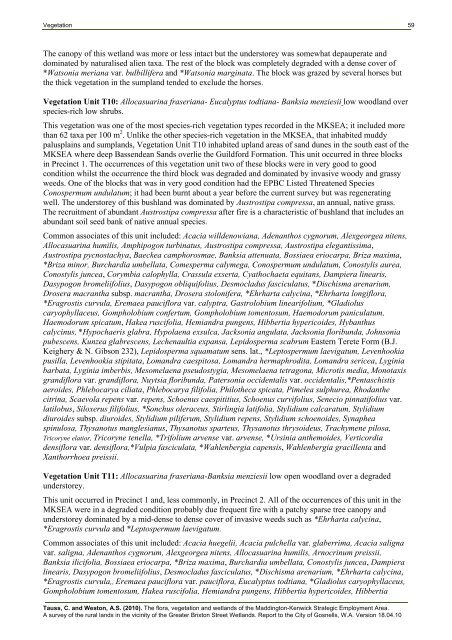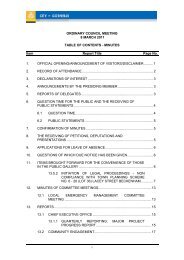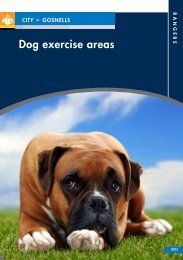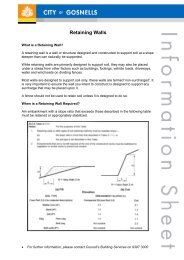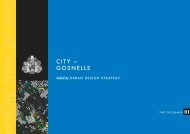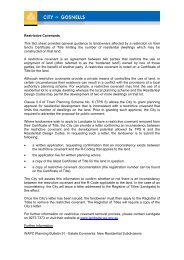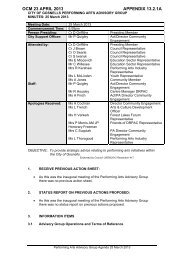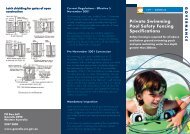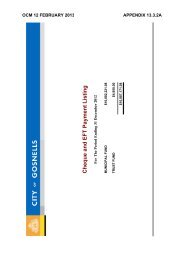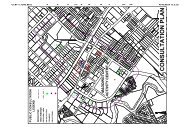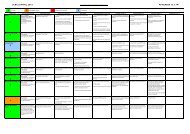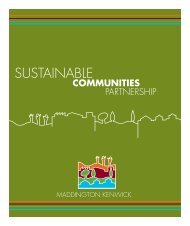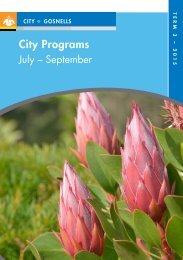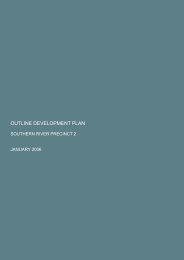Summary - City of Gosnells
Summary - City of Gosnells
Summary - City of Gosnells
You also want an ePaper? Increase the reach of your titles
YUMPU automatically turns print PDFs into web optimized ePapers that Google loves.
Vegetation 59The canopy <strong>of</strong> this wetland was more or less intact but the understorey was somewhat depauperate anddominated by naturalised alien taxa. The rest <strong>of</strong> the block was completely degraded with a dense cover <strong>of</strong>*Watsonia meriana var. bulbillifera and *Watsonia marginata. The block was grazed by several horses butthe thick vegetation in the sumpland tended to exclude the horses.Vegetation Unit T10: Allocasuarina fraseriana- Eucalyptus todtiana- Banksia menziesii low woodland overspecies-rich low shrubs.This vegetation was one <strong>of</strong> the most species-rich vegetation types recorded in the MKSEA; it included morethan 62 taxa per 100 m 2 . Unlike the other species-rich vegetation in the MKSEA, that inhabited muddypalusplains and sumplands, Vegetation Unit T10 inhabited upland areas <strong>of</strong> sand dunes in the south east <strong>of</strong> theMKSEA where deep Bassendean Sands overlie the Guildford Formation. This unit occurred in three blocksin Precinct 1. The occurrences <strong>of</strong> this vegetation unit two <strong>of</strong> these blocks were in very good to goodcondition whilst the occurrence the third block was degraded and dominated by invasive woody and grassyweeds. One <strong>of</strong> the blocks that was in very good condition had the EPBC Listed Threatened SpeciesConospermum undulatum; it had been burnt about a year before the current survey but was regeneratingwell. The understorey <strong>of</strong> this bushland was dominated by Austrostipa compressa, an annual, native grass.The recruitment <strong>of</strong> abundant Austrostipa compressa after fire is a characteristic <strong>of</strong> bushland that includes anabundant soil seed bank <strong>of</strong> native annual species.Common associates <strong>of</strong> this unit included: Acacia willdenowiana, Adenanthos cygnorum, Alexgeorgea nitens,Allocasuarina humilis, Amphipogon turbinatus, Austrostipa compressa, Austrostipa elegantissima,Austrostipa pycnostachya, Baeckea camphorosmae, Banksia attenuata, Bossiaea eriocarpa, Briza maxima,*Briza minor, Burchardia umbellata, Comesperma calymega, Conospermum undulatum, Conostylis aurea,Conostylis juncea, Corymbia calophylla, Crassula exserta, Cyathochaeta equitans, Dampiera linearis,Dasypogon bromeliifolius, Dasypogon obliquifolius, Desmocladus fasciculatus, *Dischisma arenarium,Drosera macrantha subsp. macrantha, Drosera stolonifera, *Ehrharta calycina, *Ehrharta longiflora,*Eragrostis curvula, Eremaea pauciflora var. calyptra, Gastrolobium linearifolium, *Gladioluscaryophyllaceus, Gompholobium confertum, Gompholobium tomentosum, Haemodorum paniculatum,Haemodorum spicatum, Hakea ruscifolia, Hemiandra pungens, Hibbertia hypericoides, Hybanthuscalycinus, *Hypochaeris glabra, Hypolaena exsulca, Jacksonia angulata, Jacksonia floribunda, Johnsoniapubescens, Kunzea glabrescens, Lechenaultia expansa, Lepidosperma scabrum Eastern Terete Form (B.J.Keighery & N. Gibson 232), Lepidosperma squamatum sens. lat., *Leptospermum laevigatum, Levenhookiapusilla, Levenhookia stipitata, Lomandra caespitosa, Lomandra hermaphrodita, Lomandra sericea, Lyginiabarbata, Lyginia imberbis, Mesomelaena pseudostygia, Mesomelaena tetragona, Microtis media, Monotaxisgrandiflora var. grandiflora, Nuytsia floribunda, Patersonia occidentalis var. occidentalis,*Pentaschistisaeroides, Phlebocarya ciliata, Phlebocarya filifolia, Philotheca spicata, Pimelea sulphurea, Rhodanthecitrina, Scaevola repens var. repens, Schoenus caespititius, Schoenus curvifolius, Senecio pinnatifolius var.latilobus, Siloxerus filifolius, *Sonchus oleraceus, Stirlingia latifolia, Stylidium calcaratum, Stylidiumdiuroides subsp. diuroides, Stylidium piliferum, Stylidium repens, Stylidium schoenoides, Synapheaspinulosa, Thysanotus manglesianus, Thysanotus sparteus, Thysanotus thrysoideus, Trachymene pilosa,Tricoryne elatior, Tricoryne tenella, *Trifolium arvense var. arvense, *Ursinia anthemoides, Verticordiadensiflora var. densiflora,*Vulpia fasciculata, *Wahlenbergia capensis, Wahlenbergia gracillenta andXanthorrhoea preissii.Vegetation Unit T11: Allocasuarina fraseriana-Banksia menziesii low open woodland over a degradedunderstorey.This unit occurred in Precinct 1 and, less commonly, in Precinct 2. All <strong>of</strong> the occurrences <strong>of</strong> this unit in theMKSEA were in a degraded condition probably due frequent fire with a patchy sparse tree canopy andunderstorey dominated by a mid-dense to dense cover <strong>of</strong> invasive weeds such as *Ehrharta calycina,*Eragrostis curvula and *Leptospermum laevigatum.Common associates <strong>of</strong> this unit included: Acacia huegelii, Acacia pulchella var. glaberrima, Acacia salignavar. saligna, Adenanthos cygnorum, Alexgeorgea nitens, Allocasuarina humilis, Arnocrinum preissii,Banksia ilicifolia, Bossiaea eriocarpa, *Briza maxima, Burchardia umbellata, Conostylis juncea, Dampieralinearis, Dasypogon bromeliifolius, Desmocladus fasciculatus, *Dischisma arenarium, *Ehrharta calycina,*Eragrostis curvula,, Eremaea pauciflora var. pauciflora, Eucalyptus todtiana, *Gladiolus caryophyllaceus,Gompholobium tomentosum, Hakea ruscifolia, Hemiandra pungens, Hibbertia hypericoides, HibbertiaTauss, C. and Weston, A.S. (2010). The flora, vegetation and wetlands <strong>of</strong> the Maddington-Kenwick Strategic Employment Area.A survey <strong>of</strong> the rural lands in the vicinity <strong>of</strong> the Greater Brixton Street Wetlands. Report to the <strong>City</strong> <strong>of</strong> <strong>Gosnells</strong>, W.A. Version 18.04.10


